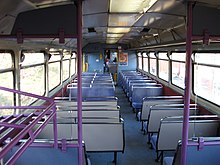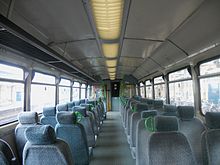
A diesel multiple unit or DMU is a multiple-unit train powered by on-board diesel engines. A DMU requires no separate locomotive, as the engines are incorporated into one or more of the carriages. Diesel-powered single-unit railcars are also generally classed as DMUs. Diesel-powered units may be further classified by their transmission type: diesel–mechanical DMMU, diesel–hydraulic DHMU, or diesel–electric DEMU.

Arriva Trains Northern was a train operating company in England owned by Arriva that operated the Regional Railways North East franchise from March 1997 until December 2004. Arriva resumed operating Northern train services again on 1 April 2016 under the Northern brand but ceased again on 29 February 2020.
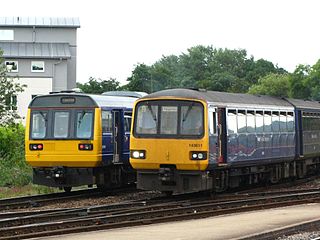
Pacer was the operational name of the British Rail Classes 140, 141, 142, 143 and 144 diesel multiple unit railbuses, built between 1980 and 1987. They were inexpensively developed using a passenger body based on the Leyland National bus on top of a chassis based on the HSFV1 research vehicle. The railbuses were intended as a short-term solution to a shortage of rolling stock, with a lifespan of no more than 20 years. As modernised replacements were lacking, the Pacer fleet remained in service on some lines until 2021 – 37 years after their introduction in 1984.

The East Kent Railway (EKR) is a heritage railway in Kent, England. It is located at Shepherdswell station on the London and Chatham to Dover mainline. The line was constructed between 1911 and 1917 to serve the Kent Coalfields. See East Kent Light Railway for details of the original lines. The Kent Collieries were mostly a failure with only Tilmanstone on the line producing any viable commercial coal and commercial traffic over the line. The line is operated by heritage diesel locomotives. It is home to a collection of heritage diesel locomotives including a British Rail Class 08, DEMU and electric multiple units including an in service British Rail Class 404 built in the 1930s and a more modern British Rail Class 365, which is to be used as a restaurant and a major events venue.

The British Rail Class 156 Super Sprinter is a diesel multiple unit passenger train. A total of 114 sets were built between 1987 and 1989 for British Rail by Metro-Cammell's Washwood Heath works. They were built to replace elderly first-generation DMUs and locomotive-hauled passenger trains.
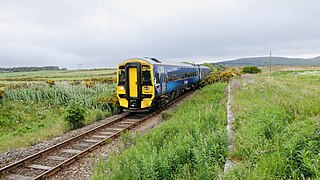
The British Rail Class 158Express Sprinter is a diesel multiple unit (DMU) passenger train. It is a member of the Sprinter series of regional trains, produced as a replacement for British Rail's first generation of DMUs; of the other members, the Class 159 is almost identical to the Class 158, having been converted from Class 158 to Class 159 in two batches to operate express services from London Waterloo to the West of England.

The British Rail Class 153 Super Sprinter are single-coach railcars converted from two-coach Class 155 diesel multiple units in the early 1990s. The class was intended for service on rural branch lines, either where passenger numbers do not justify longer trains or to boost the capacity on services with high passenger volume.

The British Rail Class 121 is a single-car double-ended diesel multiple unit. 16 driving motor vehicles were built from 1960, numbered 55020–55035. These were supplemented by ten single-ended trailer vehicles, numbered 56280–56289. They have a top speed of 70 mph (113 km/h), with slam-doors, and vacuum brakes. The driving motor vehicles were nicknamed "Bubble Cars" by some enthusiasts.

The British Rail Classes 101 and 102 diesel-mechanical multiple units were built by Metro-Cammell at Washwood Heath in Birmingham, England from 1956 to 1959, following construction of a series of prototype units. These classes proved to be some of the most successful and longest-lived of BR's First Generation DMUs, second in longevity only to the Class 121, with the final five units being withdrawn on 24 December 2003. The oldest set was, by then, just over 47 years old.
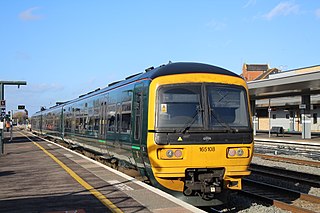
The British Rail Class 165 Networker Turbo is a fleet of suburban diesel multiple unit passenger trains (DMUs), originally specified by and built for the British Rail Thames and Chiltern Division of Network SouthEast. They were built by BREL York Works between 1990 and 1992. An express version was subsequently built in the form of the Class 166 Networker Turbo Express trains. Both classes are now referred to as "Networker Turbos", a name derived some three years later for the project that resulted in the visually similar Class 365 and Class 465 EMUs.

Northern Rail, branded as Northern, was an English train operating company owned by Serco-Abellio that operated the Northern Rail franchise from 2004 until 2016. It was the primary passenger train operator in Northern England, and operated the most stations of any train operating company in the United Kingdom. Northern Rail was replaced on 1 April 2016 by Arriva Rail North.

The British Rail Class 150 Sprinter is a class of diesel multiple-unit passenger trains, developed and built by British Rail Engineering Limited at York Carriage Works between 1984 and 1987 for use on regional services across Great Britain. The type is a second-generation design, built to more modern standards and based on BR's Mark 3 body design for longer-distance services. It was developed alongside the lower-cost Pacers, which were built using bus parts, for use on short-distance services. Two prototype units were built, followed by 135 production units in two batches. Subsequently, further members of the Sprinter family were developed and introduced to service, including the Class 155, Class 156, Class 158 and Class 159.

The British Rail Class 144Pacer is a diesel multiple unit (DMU) passenger train built at Derby between 1986 and 1987. British Rail, seeking to procure improved derivatives of the earlier Class 141, placed an order with the manufacturers British Rail Engineering Limited (BREL) and Walter Alexander to construct their own variant, the Class 144. A total of 23 units were constructed. All units have now retired from mainline service, though the majority of the units have been acquired for preservation on heritage railways and in other uses. As of December 2022, 19 out of the 23 units have been purchased following withdrawal for this purpose, of which 14 units are in operational condition.

The British Rail Class 143 is a diesel multiple-unit railbus, part of the Pacer family of passenger trains introduced between 1985 and 1986.

The British Rail Class 155 is a diesel multiple unit passenger train. These DMUs were built by Leyland Bus at Workington between 1987 and 1988 as part of BR's replacement of its ageing first-generation diesel fleet. 42 units were originally built, of which only 7 remain; the other 35 units were converted to Class 153 railcars.

The British Rail Class 210 was a type of diesel-electric multiple unit (DEMU) passenger train designed and constructed by British Rail Engineering Limited's Derby Litchurch Lane Works.

The British RailClass 141 is the first production model of the Pacer diesel multiple unit (DMU) railbus.

The Mid-Norfolk Railway has a large collection of heritage rolling stock, mostly relating to the post-war British Railways-era, from the 1950s to 1990s. The line holds several rolling-stock accomplishments:

The British Rail Class 331 Civity is a class of electric multiple unit built by CAF, owned by Eversholt Rail Group, and currently operated by Northern Trains. A total of 43 units have been built – 31 three-car units and 12 four-car units. Construction of the trains started in July 2017 and they were phased into service from 1 July 2019.

The British Rail Class 195 is a class of diesel multiple-unit passenger train from the Civity family manufactured by CAF, owned by Eversholt Rail Group and currently operated by Northern Trains. A total of 58 units have been built; 25 two-car units and 33 three-car units. The class is almost identical to the Class 331 also produced by CAF, which is the electric version of the Class 195, differing only in traction type and vehicle formation.



